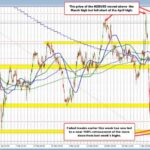
Navigating the NZD/USD Rebound: Key Insights and Market Dynamics
Tháng 4 11, 2025Rising U.S. 30-Year Treasury Bond Yields: What Investors Must Know
Tháng 4 11, 2025U.S. 30-Year Treasury Yields Set for Record Weekly Increase: What It Means for the Economy
As of April 11, 2025, U.S. 30-year Treasury yields have surged to approximately 4.95%, marking this potential weekly increase as the largest since 1982. This notable rise in yields is expected to have profound implications for various sectors, particularly influencing borrowing costs across mortgages and corporate financing. Given the complexity of economic factors at play, understanding the catalysts behind this surge is essential for investors, policymakers, and the general public.
Factors Driving the Increase in Treasury Yields
The surge in U.S. Treasury yields is largely motivated by several intertwined economic factors. Firstly, inflation expectations are rising, as consumers anticipate higher prices in the near future. Such inflationary outlook prompts investors to demand a higher yield on bonds, reflecting their desire for increased returns to offset diminished purchasing power.
Moreover, budget concerns are coming to the forefront of economic discussions. Recent parliamentary debates surrounding fiscal policies have raised alarms about potential budget deficits, thereby contributing to anxiety over macroeconomic stability. This has further solidified the perception of an economy wrestling with potential dangers.
Next, there’s evidence of slowing economic growth in the United States. As critical economic indicators show signs of deceleration, market behaviors adjust accordingly, and yield volatility tends to rise. Investors assess risk with increasing caution, leading to greater fluctuations in yields.
Adding to these challenges is a burgeoning loss of confidence in governmental economic management. As global de-dollarization efforts gain traction, skepticism surrounds the nation’s monetary policies, making investors less inclined to hold long-term bonds.
Lastly, there’s a prevailing view that the Federal Reserve is adopting a rather cautious stance toward inflation management. This perceived hesitance to intervene promptly may result in missed opportunities to counteract rising yields, leaving the economic landscape susceptible to further upheaval.
Implications of Rising Yields on the Economy
The ramifications of rising yields can be alarming, particularly in areas such as mortgage costs. With the cost of financing expected to escalate, potential homebuyers may encounter steeper mortgage rates, effectively cooling off activity in the housing market. This could lead to decreased affordability for average consumers, thereby stalling housing sales and impacting related industries. For a more detailed analysis regarding trends in mortgage costs and their implications, see our discussion on EUR/USD currency pair analysis.
Additionally, corporate borrowing will face challenges as well. Higher yields imply steeper costs of financing for businesses, which could, in turn, lead to a dip in both corporate investment and spending. The consequence of this trend could potentially stymie overall economic growth, contributing to a downward cycle where reduced investment curtails job creation and economic dynamism. This cautious economic outlook is reminiscent of the current neutral trend reported in the USD/CAD forex market, where indecision and low volatility suggest that investors are also taking a ‘wait and see’ approach; you can read more about it here.
In conclusion, the trajectory of U.S. 30-year Treasury yields is a critical indicator of economic health. Investors and policymakers must navigate this evolving landscape with care, recognizing that the tidal wave of rising yields could potentially reshape financial markets and broader economic interactions in profound ways. Active monitoring and strategic planning will be key as developments unfold. As highlighted in our recent coverage, trading strategies and geopolitical events, such as China’s economic stance, also play an integral role in shaping market outcomes.
